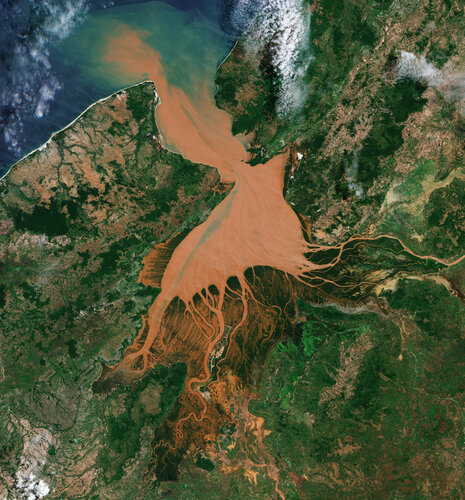Resembling a reddish jellyfish, the Mahajamba Bay in Madagascar is imaged by Copernicus Sentinel-2.
Zoom in to explore this image at its full 10 m resolution or click on the circles to learn more.
Located in the Indian Ocean off the east coast of Africa and covering almost 600 000 sq km, Madagascar is the fourth largest island in the world.
The Mahajamba Bay, also known as Helodrano Mahajambe, lies in northwest Madagascar at the confluence of two major rivers: the Mahajamba entering from the south and the Sofia River flowing from northeast. Both rivers then empty into the Mozambique Channel, which separates Madagascar from the African continent.
The Mahajamba river system, as with other river systems in western Madagascar, is distinctive for its reddish-coloured water caused by sediment from upstream. During heavy rain, the bright red soils are washed from hills into streams and rivers, eventually reaching the coast. This has also been spotted by astronauts on the ISS, who have described it as “bleeding into the ocean.” However, the bay waters are not always red – a combination of tides and lack of substantial rainfall can quickly clear the waters.
Zooming into the ‘jellyfish tentacles’ near the centre of the image reveals patterns of cultivation and land management, as well as an airstrip near Besakoa, the most prominent settlement visible.
Madagascar is home to rare flora and fauna, having developed its own ecosystems and wildlife since splitting from the African continent some 160 million years ago. The Mahajamba Bay is home to the largest mangrove ecosystems on Madagascar’s west coast. Along Madagascar’s coastlines, mangroves are the most predominant kind of vegetation, providing shelter for mollusc and crustacean communities and serving as a habitat for sea turtles, dugongs and birds.
In addition to mangroves, some of the world’s most extensive coral reef systems and a vast array of birds, lemurs, and many other species can be found here. However, preserving the country’s impressive biodiversity is an ongoing challenge.
Loss of soil through deforestation for cultivation and pasture is believed to pose a serious threat to the island’s habitats, and the illegal wildlife trade is a further challenge. Madagascar is recognised as one of the highest priority hotspots for biodiversity, with numerous international conservation organisations working together to preserve the island’s unique ecosystems.



 Image:
Resembling a reddish jellyfish, the Mahajamba Bay in Madagascar is imaged by Copernicus Sentinel-2.
Image:
Resembling a reddish jellyfish, the Mahajamba Bay in Madagascar is imaged by Copernicus Sentinel-2.